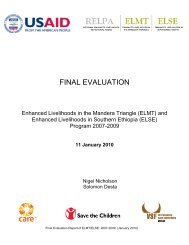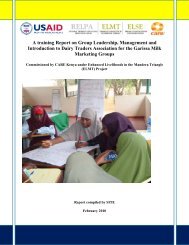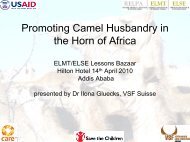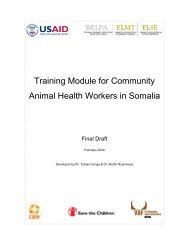Impact Assessment of the Community Animal Health System in ...
Impact Assessment of the Community Animal Health System in ...
Impact Assessment of the Community Animal Health System in ...
Create successful ePaper yourself
Turn your PDF publications into a flip-book with our unique Google optimized e-Paper software.
4. Discussion<br />
4.1 Methodological issues<br />
Tim<strong>in</strong>g <strong>of</strong> <strong>the</strong> assessment<br />
The assessment was conducted dur<strong>in</strong>g <strong>the</strong> peak <strong>of</strong> <strong>the</strong> long dry season <strong>in</strong> August 2009. Therefore,<br />
although a sampl<strong>in</strong>g list <strong>of</strong> <strong>in</strong>formants was available for <strong>the</strong> purpose <strong>of</strong> mak<strong>in</strong>g a random selection <strong>of</strong><br />
<strong>in</strong>formants, it was not possible to locate or meet most <strong>of</strong> <strong>the</strong> people selected from <strong>the</strong> list.<br />
Fur<strong>the</strong>rmore, it was not possible to identify herds which had received no treatments and which might<br />
have acted as a control group for <strong>the</strong> assessment. In part, <strong>the</strong>se limitations were overcome by<br />
compar<strong>in</strong>g CAHW‐treated and owner‐treated animals; when us<strong>in</strong>g <strong>the</strong> proportional pil<strong>in</strong>g method,<br />
<strong>in</strong>formants confidently provided this <strong>in</strong>formation. In addition, <strong>the</strong> CFR data was handled as non<br />
parametric data.<br />
Disease diagnosis, recall issues and case fatality rates<br />
The proportional pil<strong>in</strong>g method for estimation <strong>of</strong> CFR partly depends on <strong>the</strong> ability <strong>of</strong> <strong>in</strong>formants to<br />
diagnose livestock diseases with reasonable accuracy. Such diagnosis uses <strong>the</strong>ir cl<strong>in</strong>ical observations<br />
and recognition <strong>of</strong> epidemiological factors such as <strong>the</strong> seasonal occurrence <strong>of</strong> disease, contact between<br />
herds, exposure to disease vectors and o<strong>the</strong>r factors. The cl<strong>in</strong>ical diagnostic skills <strong>of</strong> pastoralists have<br />
been shown to be similar to those <strong>of</strong> veter<strong>in</strong>arians 12 .<br />
A retrospective assessment design can be h<strong>in</strong>dered by recall bias. Here we assumed that any<br />
<strong>in</strong>accuracies <strong>in</strong> remember<strong>in</strong>g treatment outcomes (deaths and survivors) would apply similarly to<br />
both CAHW‐treated and owner‐treated herds. Ideally, CFR results from CAHW‐treated herds would<br />
have been cross‐checked aga<strong>in</strong>st complete CAHW treatment records for those herds, and details <strong>of</strong><br />
drug adm<strong>in</strong>istration by species, disease, proportion <strong>of</strong> animals treated and volumes and routes <strong>of</strong><br />
drug adm<strong>in</strong>istration. This level <strong>of</strong> detailed <strong>in</strong>formation was not available.<br />
A fur<strong>the</strong>r means <strong>of</strong> cross‐check<strong>in</strong>g was a comparison <strong>of</strong> <strong>the</strong> CFRs reported by pastoralists, with <strong>the</strong><br />
literature on livestock diseases <strong>in</strong> pastoral areas. A comparison based on an <strong>in</strong>itial, brief literature<br />
search is provided <strong>in</strong> Annex 2 but affords only a very approximate means <strong>of</strong> validat<strong>in</strong>g <strong>the</strong> CFR data<br />
is this report. This is because none <strong>of</strong> <strong>the</strong> literature refers specifically to <strong>the</strong> Mandera West area and<br />
case fatality varies accord<strong>in</strong>g to biological variation <strong>in</strong> disease severity due to pathogen virulence, and<br />
factors such as <strong>the</strong> endemic or epidemic nature <strong>of</strong> a disease <strong>in</strong> a given area. Therefore <strong>the</strong>re is no<br />
standard CFR for a given disease <strong>in</strong> a particular species and for most cases, a broad range <strong>of</strong> CFRs.<br />
Ra<strong>the</strong>r than us<strong>in</strong>g <strong>the</strong> specific figures reported <strong>in</strong> <strong>the</strong> literature it is probably more useful to compare<br />
<strong>the</strong> data by categoriz<strong>in</strong>g CFRs us<strong>in</strong>g terms such as ‘high’ (e.g. CCPP, NSD, PPR, trypanosomosis),<br />
‘moderate’ (e.g. mange, sheep and goat pox, camel pox) and ‘low’ (e.g. FMD).<br />
Ano<strong>the</strong>r means <strong>of</strong> cross‐check<strong>in</strong>g would be to compare <strong>the</strong> outcome <strong>of</strong> CAHW treatments with<br />
treatments provided by veter<strong>in</strong>arians, with <strong>the</strong> latter act<strong>in</strong>g as a gold standard treatment. Initially, <strong>the</strong><br />
assessment was designed to assess herder preferences for different animal health service providers<br />
and <strong>the</strong>refore, had scope to compare CAHW and veter<strong>in</strong>arians. However, it became evident that <strong>the</strong>re<br />
were no o<strong>the</strong>r service providers <strong>in</strong> <strong>the</strong> area apart from <strong>the</strong> CAH system supported by VSF Suisse /<br />
ELMT, and <strong>the</strong> private pharmacies that belonged to <strong>the</strong> CAHWs.<br />
12 Catley, A. (2006). The use <strong>of</strong> participatory epidemiology to compare <strong>the</strong> cl<strong>in</strong>ical veter<strong>in</strong>ary knowledge <strong>of</strong> pastoralists and<br />
veter<strong>in</strong>arians <strong>in</strong> East Africa. Tropical <strong>Animal</strong> <strong>Health</strong> and Production 38, 171‐184.<br />
12












